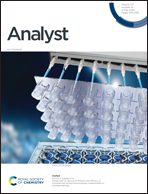Separation, identification, and confirmation of cyclic and tadpole macromolecules via UPLC-MS/MS†
Abstract
Macrocyclic poly(glycidyl phenyl ether) (pGPE) synthesized via zwitterionic ring opening polymerization is typically contaminated by chains with linear and tadpole architecture. Although mass spectrometry (MS) analysis can readily confirm the presence of the linear byproduct, due to its unique mass, it is unable to differentiate between the cyclic and tadpole structures, which are constitutional isomers produced by backbiting reactions in monomeric or dimeric chains, respectively. To overcome this problem, ultraperformance reversed-phase liquid chromatography interfaced with electrospray ionization tandem mass spectrometry (UPLC-ESI-MS/MS) was employed. The separation achieved by UPLC revealed that the tadpole isomer elutes before the cyclic structure because of the increased polarity afforded by its distinctive substituents. The ratio of tadpole to cyclic species increased with the degree of polymerization, in agreement with the synthetic method used, as the potential for forming tadpole structures by backbiting is entropically favored in longer polymer chains. Once separated, the two isomers could be independently characterized by tandem mass spectrometry. The macrocyclic and tadpole species exhibit unique fragmentation patterns, including structurally diagnostic fragments for each structure.

- This article is part of the themed collections: 150th Anniversary Collection: Mass Spectrometry and Analyst HOT Articles 2022


 Please wait while we load your content...
Please wait while we load your content...